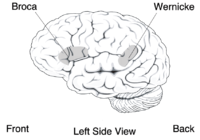
Photo from wikipedia
BackgroundEffective collaboration between speech and language therapists (SLTs) and teachers is essential in meeting the needs of children with developmental language disorders in school, but it is difficult to achieve.… Click to show full abstract
BackgroundEffective collaboration between speech and language therapists (SLTs) and teachers is essential in meeting the needs of children with developmental language disorders in school, but it is difficult to achieve. Currently, many children receive inadequate speech and language therapy services and/or support in school.The aim of this study was to engage key stakeholders (SLTs, teachers, parents and children with DLD) in the co-design of their ideal speech and language therapy service and support in school. The study was undertaken in order to inform the development of a conceptual model to guide collaborative practice when working with this population.MethodsA qualitative study involving a diverse range of key stakeholders and using appreciative inquiry. This is a method which enables those involved to construct their ‘ideal’ about a topic of interest. Recruitment was carried out using purposive sampling. We conducted focus groups with practitioners (SLTs and teachers) and parents as well as semi-structured interviews with children who have DLD using ‘draw and tell’ techniques. A total of five focus groups and nine interviews were conducted with participants (n = 27).ResultsThe children described their ideal supports as those which enabled them to connect, contribute and achieve. They describe ways in which environmental barriers in school needed to be addressed to allow them to do so. The professionals primarily described ways in which the language skills of the child could be improved. Both parents and practitioner groups described the importance of strengthening networks between service providers and service users. They also highlighted the need to promote a collaborative culture if stakeholders are to work effectively together across sectors.ConclusionsThere were differences in perspectives about the ways in which speech and language therapy services and supports could be improved, demonstrating the importance of engaging a diverse group of stakeholders. Of note were the unique insights the children brought about the barriers they faced as a result of their difficulties. Based on our findings we propose that children should be given influence in decisions about the supports that they receive in school. Implications for policy, research and practice are discussed.
Journal Title: BMC Health Services Research
Year Published: 2019
Link to full text (if available)
Share on Social Media: Sign Up to like & get
recommendations!